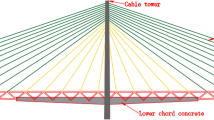Abstract
The slab of the composite girder is usually very wide in composite cable-stayed bridges, and the main girder has an obvious shear lag. There is an axial force in the main girder due to cable forces, which changes the normal stress distribution of the composite girder and affects the shear lag. To investigate the shear lag in the twin I-shaped composite girder (TICG) of cable-stayed bridges, analytical solutions of TICGs under bending moment and axial force were derived by introducing the additional deflection into the longitudinal displacement function. A shear lag coefficient calculation method of the TICG based on additional deflection was proposed. Experiments with three load cases were conducted to simulate the main girder in cable-stayed bridges. And the stress, deflection, and shear lag coefficient obtained from the theoretical method considering additional deflection (TMAD) were verified by the experimental and finite element results. A generalized verification of a composite girder from existing references was made, indicating that the proposed method could provide more accurate results for the shear lag effect.
Similar content being viewed by others
References
Reissner E. Analysis of shear lag in box beams by the principle of the minimum potential energy. Quarterly of Applied Mathematics, 1946, 4(3): 268–278
Dezi L, Mentrasti L. Nonuniform bending-stress distribution (shear lag). Journal of Structural Engineering, 1985, 111(12): 2675–2690
Kuzmanovic B O, Graham H J. Shear lag in box girders. Journal of the Structural Division, 1981, 107(9): 1701–1712
Ni Y Z, Qian Y Q. Analysis of Elastic Thin-Walled Girder Bridges. Beijing: China Communications Press, 2000 (in Chinese)
Luo Q Z, Wu Y M, Li Q S, Tang J, Liu G D. A finite segment model for shear lag analysis. Engineering Structures, 2004, 26(14): 2113–2124
Zhang Y H, Bai X, Lin L X. An improved approach for analyzing shear lag effect of box girders. China Civil Engineering Journal, 2012, 45(11): 153–158 (in Chinese)
Zhang Y H, Lin L X. Initial parameter method for analyzing shear lag effect of thin-walled box girders. Engineering Mechanics, 2013, 30(8): 205–211 (in Chinese)
Yang L F, Zhou Y E, Zeng Y F. One-dimensional finite element analysis on additional deflection and shear-lag effect of box-girders. China Civil Engineering Journal, 2013, 46(4): 71–77 (in Chinese)
Gjelsvik A. Analog-beam method for determining shear-lag effects. Journal of Engineering Mechanics, 1991, 117(7): 1575–1594
Zhu L, Su R K L. Analytical solutions for composite beams with slip, shear-lag and time-dependent effects. Engineering Structures, 2017, 152: 559–578
Li F X, Nie J G. Elastic analytical solutions of shear lag effect of steel-concrete composite beam. Engineering Mechanics, 2011, 28(9): 1–8 (in Chinese)
Zhang Y H, Lin L X. Shear lag analysis of thin-walled box girders based on a new generalized displacement. Engineering Structures, 2014, 61: 73–83
Zhu L, Nie J G, Ji W Y. Positive and negative shear lag behaviors of composite twin-girder decks with varying cross-section. Science China Technological Sciences, 2017, 60: 116–132
Lezgy-Nazargah M, Vidal P, Polit O. A sinus shear deformation model for static analysis of composite steel-concrete beams and twin-girder decks including shear lag and interfacial slip effects. Thin-Walled Structures, 2019, 134: 61–70
Dezi L, Gara F, Leoni G. Effective slab width in prestressed twin-girder composite decks. Journal of Structural Engineering, 2006, 132(9): 1358–1370
Zhang Y L. Theoretical analysis and experimental research on behavior and crack control of negative moment zone in steel-concrete composite girders. Dissertation for the Doctoral Degree. Beijing: Beijing Jiaotong University, 2009 (in Chinese)
Wang C S, Zhang W T, Li H T, Zhai X L, Xin Y F. Shear lag effect of twin I-shaped composite girders in cable-stayed bridges. Thin-Walled Structures, 2022, 180: 109822
Zhu L, Nie J G, Li F X, Ji W Y. Simplified analysis method accounting for shear-lag effect of steel-concrete composite decks. Journal of Constructional Steel Research, 2015, 115: 62–80
Luo Q Z, Tang J, Li Q S. Finite segment method for shear lag analysis of cable-stayed bridges. Journal of Structural Engineering, 2002, 128(12): 1617–1622
Timoshenko S, Goodier J N. Theory of Elasticity. 2nd ed. New York: McGraw Hill, 1951
Hu H C. Variational Principle of Elasticity and Application. Beijing: Science Press, 1981 (in Chinese)
Fan L C. Bridge Engineering. Beijing: China Communications Press, 2012 (in Chinese)
Wu W Q. Research on shear-lag effect in combined box-girder with corrugated steel webs. Dissertation for the Doctoral Degree. Nanjing: Southeast University, 2002 (in Chinese)
Gimsing N J, Georgakis C T. Cable Supported Bridges: Concept and Design. 3rd ed. Hoboken, NJ: Wiley, 2012
Wang C S, Zhang W T, Zhou M M. Shear Lag Effect of Composite Girders in Cable-Stayed Bridges. Report of Technical Research Project. 2019 (in Chinese)
GB 50010–2010. Code for Design of Concrete Structures. Beijing: China Architecture & Building Press, 2015 (in Chinese)
Lin Y, Yan J, Wang Z, Fan F, Zou C. Ultimate capacity and failure mechanism of SCS and S-UHPC composite deep beams: Test and modeling. Engineering Structures, 2021, 245: 112874
Li F X. Spatial structural behavior and time-dependent analysis of composite cable stayed bridge. Dissertation for the Doctoral Degree. Beijing: Tsinghua University, 2011 (in Chinese)
Acknowledgements
This work was supported by China National Ten Thousand Talents Program (No. W03020659), Shaanxi Key Science and Technology Innovation Team Project (No. 2019TD-022), and Special Support Plan for Key Research Directions of Green Highways in Central University Basic Research Business Fees of Chang’an University (No. 300102219309).
Author information
Authors and Affiliations
Corresponding author
Ethics declarations
Conflict of Interests The authors declare that they have no conflict of interest.
Rights and permissions
About this article
Cite this article
Zhang, W., Duan, L., Wang, C. et al. A theoretical model for investigating shear lag in composite cable-stayed bridges. Front. Struct. Civ. Eng. 17, 1907–1923 (2023). https://doi.org/10.1007/s11709-023-0995-5
Received:
Accepted:
Published:
Issue Date:
DOI: https://doi.org/10.1007/s11709-023-0995-5



